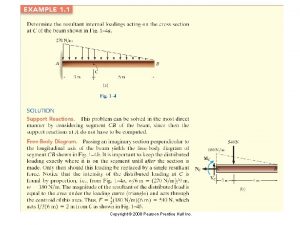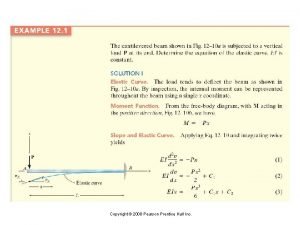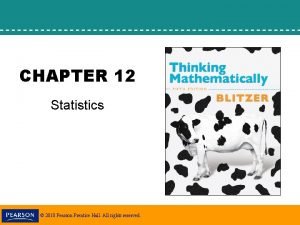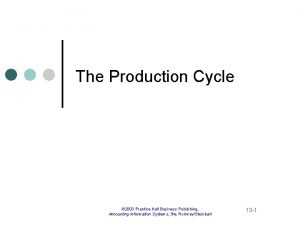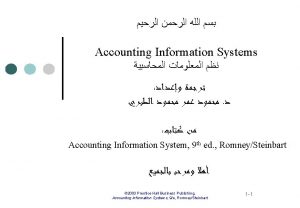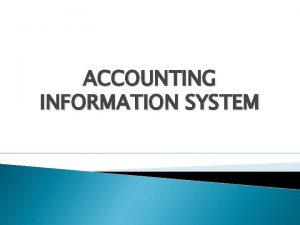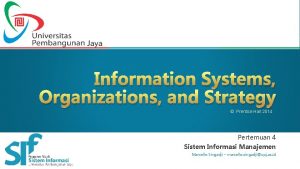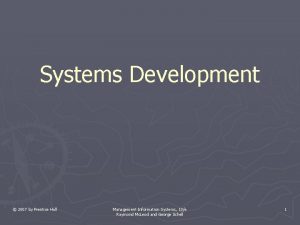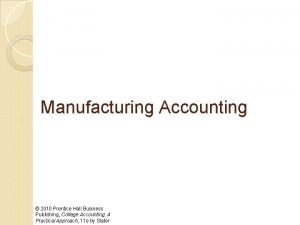Accounting Information Systems An Overview 2004 Prentice Hall
















- Slides: 16

Accounting Information Systems: An Overview 2004 Prentice Hall Business Publishing, Accounting Information Systems, 9/e, by Bodnar/Hopwood 1– 1

Learning Objective Understand the related concepts of transaction cycles and internal control structure. 2004 Prentice Hall Business Publishing, Accounting Information Systems, 9/e, by Bodnar/Hopwood 1– 2

Overview An accounting information system (AIS) is a collection of resources designed to transform data into information. Accounting information systems perform this transformation. Manual Computerized 2004 Prentice Hall Business Publishing, Accounting Information Systems, 9/e, by Bodnar/Hopwood 1– 3

Information and Decisions Who are the two main users of accounting information? External users Internal users 2004 Prentice Hall Business Publishing, Accounting Information Systems, 9/e, by Bodnar/Hopwood 1– 4

Information and Decisions Who are the external users of accounting information? Stockholders Investors Creditors Government agencies Customers and vendors 2004 Prentice Hall Business Publishing, Accounting Information Systems, 9/e, by Bodnar/Hopwood 1– 5

Information and Decisions Hierarchy of Internal Users Top-Level Management Middle Management Lower-Level Management Strategic Tactical Summarization and Filtration Operational Transaction oriented 2004 Prentice Hall Business Publishing, Accounting Information Systems, 9/e, by Bodnar/Hopwood 1– 6

Information Systems The term information system suggests the use of computer technology in an organization. Hardware Data Information Software 2004 Prentice Hall Business Publishing, Accounting Information Systems, 9/e, by Bodnar/Hopwood 1– 7

Information Systems Electronic Data Processing System (EDP) Data Processing System (DP) Management Information System (MIS) Decision Support System (DSS) Expert System (ES) Executive Information System (EIS) Accounting Information System (AIS) 2004 Prentice Hall Business Publishing, Accounting Information Systems, 9/e, by Bodnar/Hopwood 1– 8

Business Processes Data Organizational units Logical time sequence 2004 Prentice Hall Business Publishing, Accounting Information Systems, 9/e, by Bodnar/Hopwood 1– 9

Business Processes Primary Business Processes Inbound sales logistics Outbound sales logistics Marketing Operations Service 2004 Prentice Hall Business Publishing, Accounting Information Systems, 9/e, by Bodnar/Hopwood 1 – 10

Business Processes Supporting Business Processes Procurement Technology development Human resources Firm infrastructure 2004 Prentice Hall Business Publishing, Accounting Information Systems, 9/e, by Bodnar/Hopwood 1 – 11

Transaction Processing Cycles 1. Revenue cycle 2. Expenditure cycle 3. Production cycle 4. Finance cycle 2004 Prentice Hall Business Publishing, Accounting Information Systems, 9/e, by Bodnar/Hopwood 1 – 12

Internal Control Process Reliability of financial reporting Effectiveness and efficiency Compliance 2004 Prentice Hall Business Publishing, Accounting Information Systems, 9/e, by Bodnar/Hopwood 1 – 13

Internal Control Process What are the elements of internal control? Control environment Risk assessment Control activities Information and communication Monitoring 2004 Prentice Hall Business Publishing, Accounting Information Systems, 9/e, by Bodnar/Hopwood 1 – 14

Internal Control Process Segregation of Duties: No individual or department should control the accounting records relating to its own operation. Internal Auditing: It is an independent appraisal activity within the organization. 2004 Prentice Hall Business Publishing, Accounting Information Systems, 9/e, by Bodnar/Hopwood 1 – 15

QUESTIONS ? ? ? 2004 Prentice Hall Business Publishing, Accounting Information Systems, 9/e, by Bodnar/Hopwood 1 – 16
 Copyright 2008
Copyright 2008 2008 pearson prentice hall inc
2008 pearson prentice hall inc 2008 pearson prentice hall inc
2008 pearson prentice hall inc 2005 pearson prentice hall inc
2005 pearson prentice hall inc Pearson prentice hall
Pearson prentice hall Prentice hall inc
Prentice hall inc Prentice hall careers
Prentice hall careers Prentice hall america pathways to the present
Prentice hall america pathways to the present Pearson education, inc. publishing as prentice hall
Pearson education, inc. publishing as prentice hall Prentice hall business publishing
Prentice hall business publishing Prentice hall african american history
Prentice hall african american history Prentice hall physical science concepts in action
Prentice hall physical science concepts in action Pearson education inc publishing as pearson prentice hall
Pearson education inc publishing as pearson prentice hall Ocean fisheries
Ocean fisheries Pearson prentice hall
Pearson prentice hall 2005 pearson prentice hall inc
2005 pearson prentice hall inc Pearson education inc publishing as pearson prentice hall
Pearson education inc publishing as pearson prentice hall

